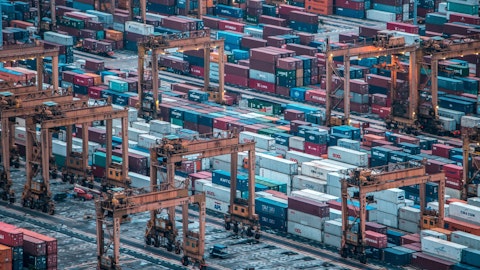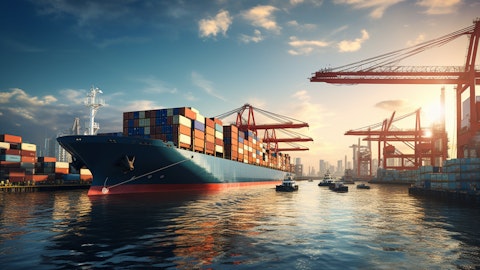Anthony Gurnee: I think a year ago we were really excited. Now we’re settling in and getting used to $35,000 a day. So joking aside, I think a year ago we were thinking, right, this is a blip, and it’s going to be over. And when it’s over, we’re going to be in a much better position financially, and we know what to do in terms of acquiring assets. Now it’s a little more difficult, but again, we don’t feel compelled to do anything other than what we think just makes sense in terms of long-term value. Yeah. Yes, sir.
Bryan Degnan: Yeah, you got just there.
Anthony Gurnee: Go ahead.
Unidentified Analyst: What percentage – oh, thank you. Do you hedge any of your fuel costs actively? And second, do you lease new ships coming on as they are built, rather than purchase them outright?
Anthony Gurnee: Do you want to address fuel? And maybe you can address leasing?
Gernot Ruppelt: Yes, generally, we don’t really hedge. We hedge our fuel needs. There could be certain specific examples if we had a corresponding long or short exposure on a particular freight element and if we wanted to then lock in the corresponding TCE, we could, in theory, lock in the fuel as well. But we generally don’t do that, essentially not really all markets, to play the oil markets and such.
Bart Kelleher: And then on the question on vessels and financing, so I guess, we don’t have any new build on order coming in that we would potentially put on leasing structures or drawdown debt. But the company in the last year and a half has really focused on the balance sheet and the shifting of debt back to the traditional shipping banks, predominantly European based, and where they’ve been able to provide us 100% coverage in some cases of revolving credit facilities, which gives us tremendous flexibility, even within a quarter to manage debt levels and decreased interest expense. And so through that delevering, we’ve been able to pull our break even down. If we hadn’t done that, it would be probably $3,500 a day north of $17,000 a day, and it’s below $14,000 today.
And so I think the key thing for us is always maintaining a really wide network and relationship of financial capital providers. We’ve had significant leasing structures in the past. We still have a few, but much more focused on the traditional shipping lines today.
Bryan Degnan: And if I could just say, everybody could please make sure you speak into the microphones. I appreciate that we took a moment to get to you, but in general, speak into them. And if we could, turn up the volume on the mics hearing on the webcast, because it’s a bit tough to hear.
Anthony Gurnee: All right. Where’s the mic?
Unidentified Analyst: Thank you very much, guys.
Bryan Degnan: Wow.
Unidentified Analyst: Tony, you mentioned like the past four or six cycles. One thing that seems a little different this time around is that a lot of the companies have less leverage. If you think back to the kind of those previous cycles, it’s been a real scramble for cash flow and equity issuance. Now it feels like very different. And certainly, your balance sheet is remarkably healthy. What difference do you think that will make on this particular market in terms of the behavior of owners.
Anthony Gurnee: Good question. I’m trying to think like the last strong market we had was in the 2020 [ph]. So people were very busy ordering ships at that point for incredible prices. And when it all came off, so there’s a lot of carnage. So it feels like companies are a lot more sensible now. They may also be held back by the considerations around the energy transition and alternative fuels, et cetera. So – and like if you look at the dry bulk sector, they’ve been at this longer now. And there’s been a remarkable restraint in ordering activity there. So, I think it’s just a different mindset. Maybe as a result of social media.
Unidentified Analyst: [Question Inaudible]
Anthony Gurnee: It could be, yes. Great.
Unidentified Analyst: This is an idea of a question of the new market. That may be arising in California that displays 53% of the diesel with renewable diesel. So you have – and refineries are shutting down or not connected by pipeline. So with each barrel of gasoline that you produce a certain amount of diesel, which may not have a home. What type of market could that be for the product tanker industry?
Gernot Ruppelt: Yes. I think you’re touching on a few really interesting points. I mean, one, something we certainly see right now how the conversations are changing with our also petroleum-based customers, some of the sort of really large and main commodity traders are now quite actively engaging in trading and certainly also more forward-looking discussion on biofuels, renewable aviation fuels, blending components for biofuels. And with that, it just comes more complexity. As you’re saying, we need different components, different feedstocks to generate those biofuels. We need different blending components for that. We need different ships and different onshore capabilities and organizational capabilities to handle those in, first of all, a safe, but most importantly, also an economic way, and the mismatch that you described where any refinery already today has a given product slate.
And of course, you can do things to adjust that product slate, but it will never be perfectly matching a regional market. As a matter of fact, they will continue to change, and that creates product overhang that essentially then gets discounted in terms of price and that will get exported somewhere else. So for us, this is kind of part of this really exciting story where driven through the energy transition needs and some focus on renewable fuels, but also just an increasing complexity. So conversely, imagine a world where there was only one fuel that fits everything that moves, that would be a far less complex world and probably would be a lot less interesting in terms of tanker demand. And as you’re moving away from that towards more complexity, more product grades, that creates different trade lanes and more interesting ways for us to also arbitrage that.
And yes, but it’s very much happening. I mean, some of those conversations, two or three years ago just simply didn’t take place. And just recently, we had one of the European refiners approach us and basically ask us for – could almost argue like a tutorial, like a walk-through on some of these newer cargoes and what to observe when shipping those cargoes from an operational and commercial standpoint. And we find that as a nice validation of the reputation we have created in those markets to be well beyond just diesel and gasoline, which of course, still today is a bulk of what we do, but we can do a lot more than that.
Bryan Degnan: Okay, we’ve got one appear and then Chris subsequently.
Unidentified Analyst: Thank you. It was also the philosopher Heraclitus that said, “the only constant in life is changed”. So maybe if I could ask some questions regarding some ways that are on the horizon. I was looking at your presentation in the route. And is your baseline, the Suez canal blockage, I’m wondering that’s just happening right now. When things normalize, how is that going to affect your business when you have to return to your normal routes? How is that going to benefit your competitors and how it’s going to affect the financials of – revenues for the company please?
Anthony Gurnee: Gernot, you want to talk?
Gernot Ruppelt: Yes, I can take a stab at this. So, I think just maybe a comment on timing. And the quote that you just mentioned is very much highlighted in various internal and external debates we have, and I think it’s very much of what – as I said, our trading mantra is based on it. We are in a very changing environment. And for us to trade well in this. We just have to really embrace that. I don’t think that, unfortunately, the situation in the Red Sea is going to solve itself overnight. And I believe that even some other factors like the situation in Russia and Ukraine, even if there was a peace that were to find – a peaceful solution to the conflict I think some of those trades that we’re seeing now that have changed as a result of this will be quite sticky.
I don’t necessarily foresee the world going back to just how things used to be before than overnight. I think that’s a really good and valid question and the question we ask ourselves all the time, if we took some of those components out of the equation, where would the market be today? What is the baseline? And that’s a tough one to answer, but I think what we certainly shouldn’t take as a baseline is 2021, which is COVID. I think it’s really important to remember that just before the world went into this lock down and the subsequent terrible tanker market that ensued a lot of positive things were actually happening. The fuel switch created a lot of complexity around diesel shortages. Europe is already structurally short of diesel.



